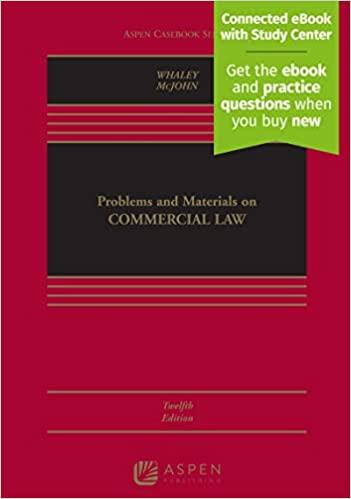Question
Business ethics 978 Case study 776UT: : Using the New FASB Revenue Recognition Rules 47 Part 1: 2. How does each step in the five-step
Business ethics 978
Case study 776UT: : Using the New FASB Revenue Recognition Rules 47 Part 1: 2. How does each step in the five-step revenue model apply to this transaction? a. Step 1: The contract with the customer is that the bartender will provide a cup of beer in exchange for $5 from the customer. b. Step 2: The performance obligation in this transaction is to provide the customer with one cup of beer. c. Step 3: The transaction price in this situation is $5 for one cup of beer. d. Step 4: The transaction price will be allocated to the goods involved in the performance obligations, which is beer in this case. e. Step 5: The revenue will be recognized immediately in this case, as the performance obligation and collection of payment happen at the same time. 3. Part 2: 2. How does each step in the five-step revenue model apply to this transaction? a. Step 1: In this case, the contract with the customer is similar to part I: the bartender will provide a large beer in a thermal mug in exchange for $7 from the customer. b. Step 2: The performance obligation in this transaction is to provide the customer with one large thermal mug of beer. c. Step 3: The transaction price in this case is $7 for the large thermal mug of beer. Cash $7 Revenue - Beer 7 48 d. Step 4: In this case, the transaction price will be allocated based on the relative standalone price of the individual items. Here, the beer will be allocated to the total transaction price as ($5/8)*7, which is $4.38. The mug will be allocated as ($3/8)*7, which is $2.62. e. Step 5: The revenue will be recognized immediately in this case because the performance obligation is fulfilled when the bartender exchanges the customer's money for the beer and mug. 3. Part 3: 1. How does each step in the five-step revenue model apply to this transaction? a. Step 1: In this scenario, the contract with the customer is the bartender providing the beer and pretzel in exchange for $7 from the customer. b. Step 2: The performance obligation in this transaction is to provide the customer with a cup of beer and one pretzel. c. Step 3: The transaction price is $8.50, because it is the two standalone prices for the beer and the coupon added together. d. Step 4: The transaction price will be allocated to the beer ($5/8.50)*7, which is $4.12. The coupon will be allocated to unearned revenue as ($3.50/8.50)*7, which is $2.88. e. Step 5: Revenue will only be recognized for the beer, as the performance obligation for the pretzel has not been fulfilled. The coupon will instead be recorded as unearned revenue. Cash $7 Revenue - Beer 4.38 Revenue - Mug 2.62 49 2. Part 4: 1. How does each step in the five-step revenue model apply to this transaction? a. Step 1: The contract is to provide the customer with two pretzels in exchange for $4 or a coupon. b. Step 2: The performance obligation is to provide the customer with two pretzels. c. Step 3: The transaction price in this situation is $3.50 for two pretzels because that is how much a coupon for two pretzels costs. d. Step 4: The transaction price will be allocated will be allocated to the pretzels in this transaction. Based on how much the coupon was recorded for in part 3, the revenue will be recorded as $2.88. e. Step 5: The revenue will be recognized immediately because the performance obligation is fulfilled at the time of payment. 2. Cash $7 Revenue - Beer 4.12 Unearned revenue 2.88 Unearned revenue - pretzel $2.88 Revenue - pretzel 2.88
Question 50 What type of painful stimuli can be applied in calculating the Glasgow Coma Scale for both motor and eye-opening responses, and how should these be applied? Question 51 How can the Glasgow Coma Scale be assessed in a patient with receptive or expressive aphasia? Question 52 How common is it for someone suffering a transient ischaemic attack (TIA) to totally lose consciousness? Also, what is the mechanism for losing consciousness with a TIA? Question 53 What should the management be for a stenosis in the carotid artery causing transient ischaemic attack (TIA), and when is surgery recommended? Question 54 In a patient with central retinal artery branch occlusion with carotid artery stenosis, what is the best management: warfarin, aspirin or carotid endarterectomy? Question 55 If a young patient who has suffered a stroke has a normal mental state, would this exclude a cerebral venous occlusion as an aetiology? Question 56 Does persistent hiccough following cerebrovascular ischaemic stroke localize to the medulla or to any other site? Question 57 By what mechanism is vertebrobasilar insufficiency associated with circumoral numbness? Question 58 Why does lateral medullary syndrome result in ipsilateral diplopia due to cranial nerve VI? Neurological disease 21 227 Question 59 I have seen many established ischaemic stroke patients with CTdocumented capsular infarction and hemi-hypotonia despite exaggerated reflexes. How would you explain the hypotonia? Could it be due to a corticorubral fibre lesion? Question 60 Thrombolytic therapy is used in patients with a cerebral infarct within the first 3 hours, whereas stroke by definition lasts 24 hours. So how do we define that it is infarct and not a transient ischaemic attack (TIA) on a CT scan within the first 3 hours in order to start tissue plasminogen activator (tPA) treatment?
Step by Step Solution
There are 3 Steps involved in it
Step: 1

Get Instant Access to Expert-Tailored Solutions
See step-by-step solutions with expert insights and AI powered tools for academic success
Step: 2

Step: 3

Ace Your Homework with AI
Get the answers you need in no time with our AI-driven, step-by-step assistance
Get Started


